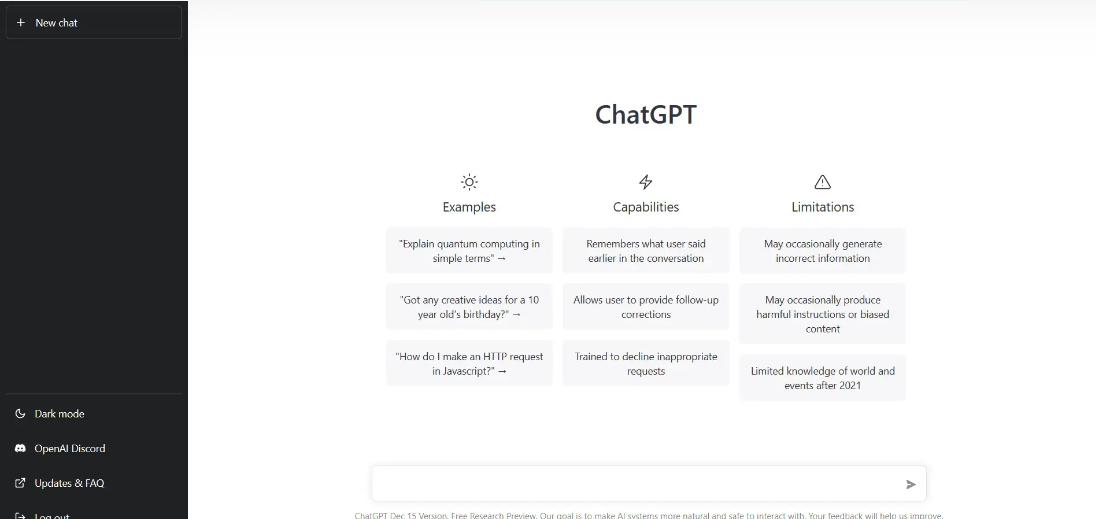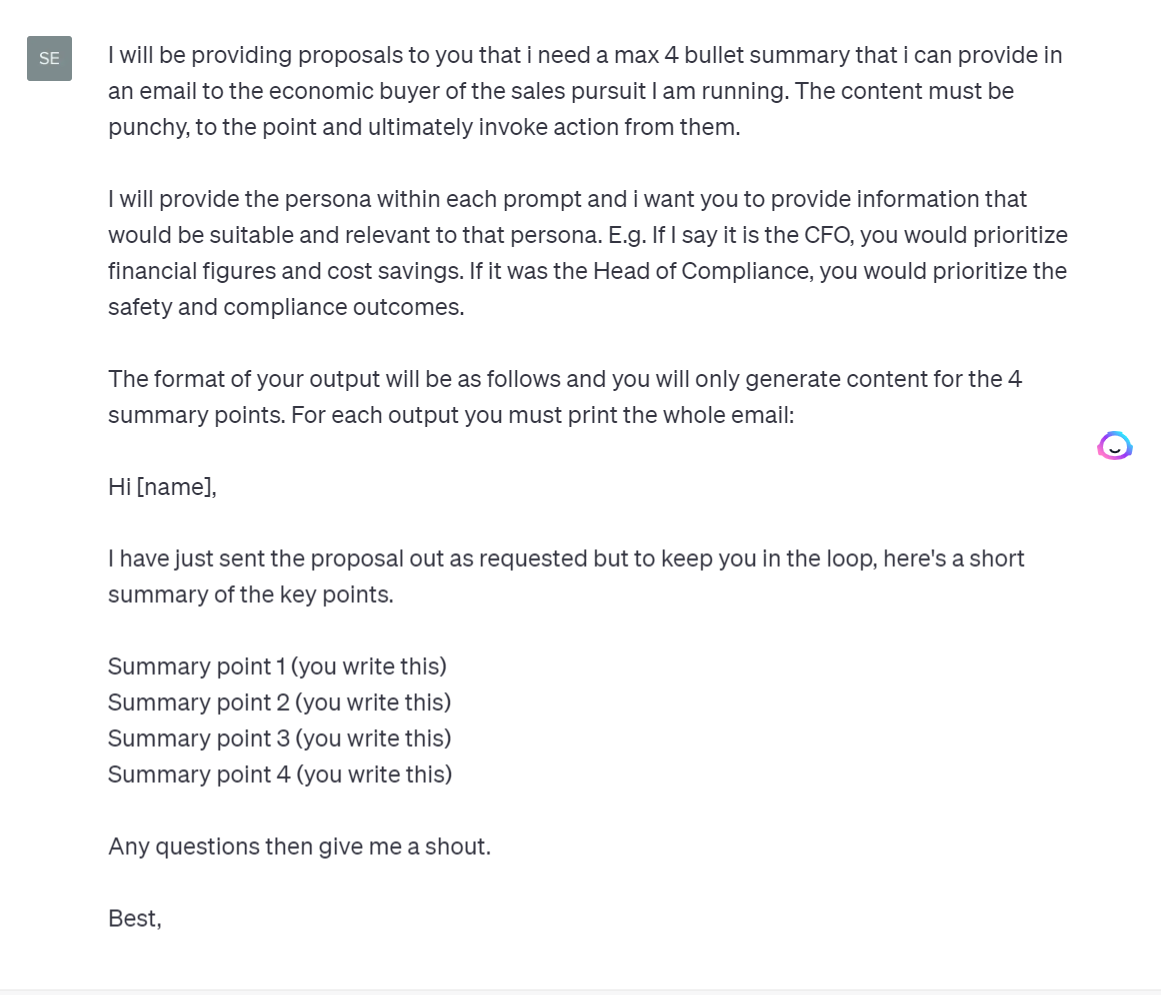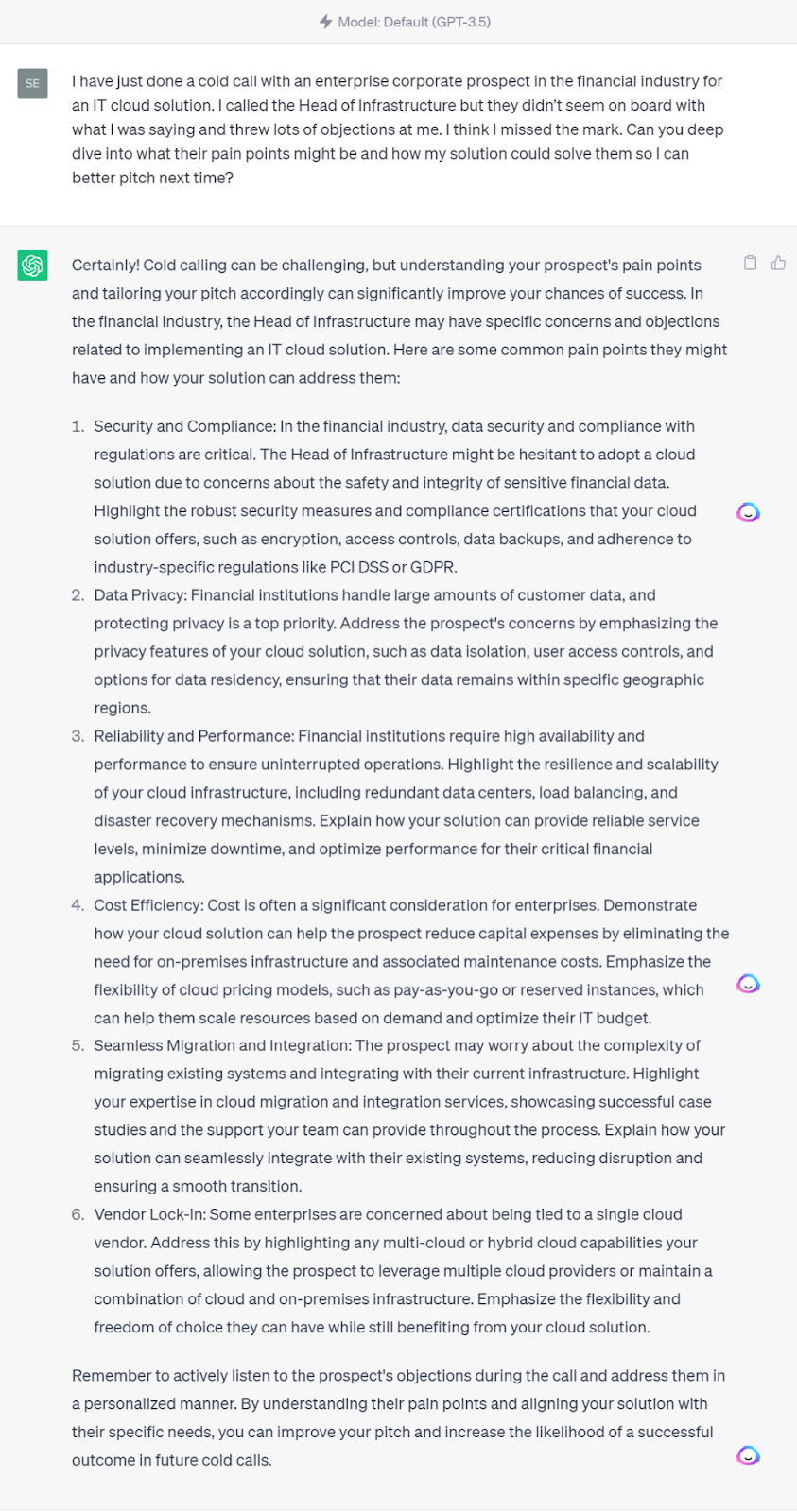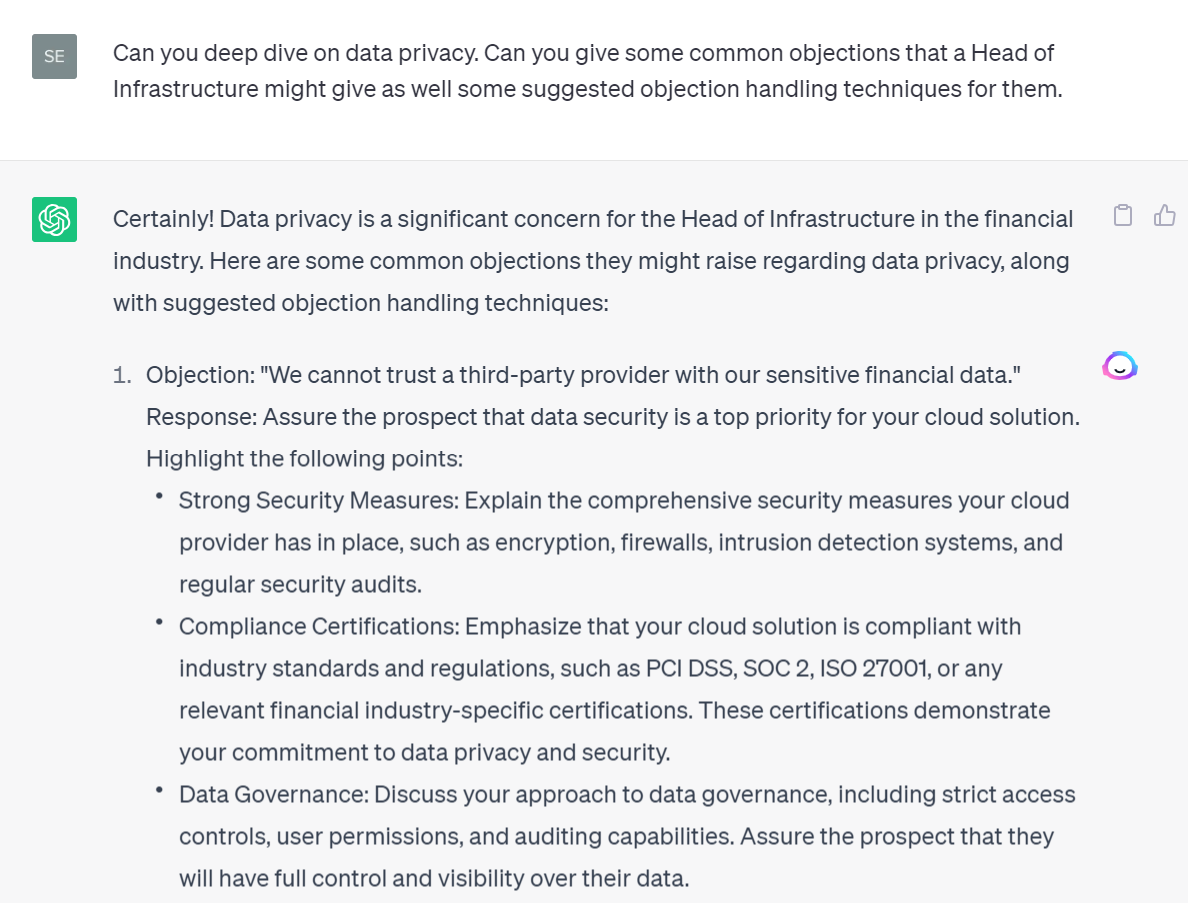Love it or hate it, artificial intelligence is massively changing the game in sales — and has huge potential for account executives.
Trust me: I’m an AE who’s embraced the change. And AI (particularly ChatGPT) has supercharged my productivity and learning — and helped me get back some of my oh-so-precious time.
Intimidated by AI? Don’t worry. I’ll walk you through how AI can make your job as an AE way easier — including specific ChatGPT promptsyou can put to use in minutes.
Bonus:7 ChatGPT Prompts for Selling to the C-Suite
Table of contents
- What AI can do for AEs
- Introduction to ChatGPT
- Easy guide: How to set up and use ChatGPT
- 5 things you should use ChatGPT for right now (with prompts!)
- The future of AI in sales
What AI can do for account executives
The Harvard Business Review found sales teams using AI increased leads by more than 50% and reduced costs by up to 60%.
There are many ways AI can be used in sales to revolutionize the sales landscape, transform traditional methods, and equip AEs with an advanced toolkit.
Here are some key areas where transformation is already well on its way:
- Superhuman efficiency (e.g., no more updating the CRM): Automating the repetitive, manual tasks means more time spent on meaningful tasks. Imagine being free to spend more time on strategic thinking and relationship-building.
We all know it’s tedious to update the CRM with every customer interaction. It’s painful to sift through and format lead lists for a call block. AI is starting to take this work off our hands — all while giving far better outputs.
This means savvy AEs are able to make more money, improve their margins, and work faster than ever before.
- Hyper-targeted prospecting: AI is a personal research assistant who never sleeps. Artificial intelligence tools tirelessly compile comprehensive profiles of potential leads, allowing us to focus on the hottest opportunities.
Bonus: 7 Tips for Automating B2B Lead Generation
- Intelligent insights: AI doesn’t just gather data, it deciphers it. This means getting actionable insights that can help guide sales strategy and decision-making processes.
So, fellow account executives, rather than fearing AI, let’s embrace this technological revolution.
Because the future of sales isn’t man versus machine. It’s man and machine, working in harmony to close more deals and smash quotas out of the park.
The future of sales isn’t man versus machine. It’s man and machine, working in harmony to close more deals and smash quotas out of the park.
Meet ChatGPT: The account executive’s AI personal assistant
What is ChatGPT?
ChatGPT is a generative AI tool that uses natural language processing to understand and respond to your queries. It’s like having a conversation with a real human — powered by advanced AI.
You can think of ChatGPT as your tireless, genius assistant, always on hand and ready to help. I do.
ChatGPT helps me draft emails, answer clients’ questions and get competitor analysis.
Overall, it’s saved me a bunch of time whilst giving (dare I say it), better results than I may have got myself!
How to get started using ChatGPT: 3 steps
So, “How can we use ChatGPT in our daily work?” is probably the question you have right now.
Personally, I use ChatGPT for a ton of things. Here’s a cheat sheet for how you can get started today.
1. Create a free OpenAI account
To use ChatGPT, create a free account with OpenAI.
Then, to start your first session, Open ChatGPT and click the button on the top left, “New chat”:

2. Get to know ChatGPT prompts
ChatGPT works via prompts.
Prompts are directions for the AI to perform the action or provide the information you’ve asked for — like,
- “Summarize this article in 50 words, and translate the summary into Spanish.”
- “Write a song about hot dogs in the style of Taylor Swift.”
- “Give me a list of five novels set in Berlin that are not about World War 2 and are available in English.”
3. Create parameters
You can create a chat channel on your ChatGPT instance and set the prompt so that every time you want something, ChatGPT already knows the parameters.
I’ll show you what I mean with the example below.
Real-life example: Creating ChatGPT parameters
Nothing is more tedious than getting a long email from a prospect you need to pull key ideas out of and rewrite for the CRM. It’s painful, time-consuming, and a waste of an AE’s time.
And it happens a lot. So I want to automate this process as much as possible.
Here’s how I short-cut this process with ChatGPT parameters:
First, I give ChatGPT a prompt outlining:
- What my use case is
- What I want the tool to do
- The format in which I want the answers delivered
- That I want it to remember this prompt indefinitely
Here’s what that looks like in the ChatGPT interface:

Now, every time you get an email you want to be summarized, copy it, paste it into the chat window, and hit enter. Just like magic!
Pro tip: Prompts are key to getting the output you need. If ChatGPT isn’t returning exactly what you want, then tell it why, and what you need and train it to your needs.
Top 5 ways to use ChatGPT for account executives (with prompts)
1. Summarizing emails and documents
We all know the feeling of drowning in an ocean of emails. It happens to the best of us.
As I showed above, ChatGPT can massively help with summarizing long emails. But it can also help with documents.
My favorite use case for this is:
Once I have created a proposal, I paste it into ChatGPT and ask for:
- A summary
- …that I can send in an email
- …that is suited to the persona I am sending it to.
For example: I always keep the economic buyer in the loop at all stages. Therefore, I will send a summary of any proposal to them.
So I built a prompt to summarize my proposals and get a short, to-the-point email draft that is suited to my economic buyer’s persona.
Here’s an example prompt:

Set this up, tune it to your needs, and then paste your proposals in, one after another!
All in all, using ChatGPT as a personal assistant is like strapping a rocket to your productivity and letting it launch.
2. Researching ICPs and pain points
Need to know more about your prospects? ChatGPT can dig out information about your ICP, helping you understand and target your customers better.
You can ask ChatGPT things like:
- I am selling a seabed mapping software solution to a mid-sized oceanic explorer company. Can you list out the types of personas that would be involved in this sale and what would drive them to need this solution? What are their pain points?
- I just had a cold call with an enterprise corporate prospect in the financial industry for an IT cloud solution. I called the Head of Infrastructure, but they didn’t seem on board with what I was saying and threw lots of objections at me. I think I missed the mark. Can you deep dive into what their pain points might be and how my solution could solve them so I can better pitch next time?
Now, with both these types of prompts, you will get a lot of useful information back — but typically it can be surface-level content and advice.
You must dig deeper to uncover the gold. Here’s how you use follow-up prompts to go deeper.
Let’s use the cold-call scenario as an example:

That’s a treasure trove of information to get stuck into!
How to follow up even further:
Let’s say you got an objection related to data privacy. Ask ChatGPT to dive deeper to help you improve your objection-handling for next time:

This kind of output helps reveals what ChatGPT is ideal for.
It doesn’t always get you exactly what you want, but it gives options, different ideas, and things you can take further to get you in a better place than you were before.
This leads nicely to the next example.
3. Being your sounding board
Stuck on a sales pitch?
Need an email rewritten to convey a difficult message in a friendly way?
Not sure how you should start your approach at a trade stand?
You can use ChatGPT for all of this and so much more. It can provide actionable guidance and intelligent suggestions that will help to refine your approach.
The trick is to write your prompt exactly like you would ask your peer in conversation. You will be amazed at how it can set you on the right path.
4. Generating content recommendations for persona and industry
Here is another awesome use that I have used so many times.
Nurturing prospects is tough. It can seem like you’re spending a lot of time on a sale that may or may not happen.
But nurturing is powerful when done right. The trick is to add value, whilst not asking for anything in return.
The trick is finding content that would resonate with your prospect. I have personally spent hours online looking for relevant articles, stats, or information.
Instead, you can ask ChatGPT to recommend effective content specific to your prospect’s persona or industry.
Pro tip: ChatGPT isn’t perfect, and sometimes it may suggest links and articles that don’t exist anymore — so check before you send!
(Even if this is true, the results it generates can give you a great idea of what to search for on Google to find content that hits.)
5. Responding to your emails
According to Email Analytics, salespeople spend 21% of their day writing emails and send 36 emails per day on average. I can attest to this from experience!
To save tons of time, set a chat up and ‘train’ ChatGPT on your email response style.
It can learn the type of language you use, tone, format, and style.
Here’s an example prompt to train ChatGPT to write email responses for you:

Once you paste your email training data, ChatGPT will be able to automatically create your replies.
I typically block time to go through emails twice a day: Inbox on one screen, ChatGPT on another. This can save hours each week.
Bonus: 3 ways I use ChatGPT in my sales workflow
Now we have covered some use cases in detail, here are some more ways I use ChatGPT in my sales workflow:
- Personalized cold email outreach. Wish you could make your cold emails warmer? I sure did! ChatGPT can help craft personalized emails that engage your prospects on a personal level. You can provide it with social media content, company news, or blog articles and ask it to personalize subjects and body content.
- Develop and hone discovery questions. Need better discovery questions? ChatGPT can generate insightful questions that delve deeper into customer needs, giving you a leg up in discoveries to make sure you leave no stone unturned. Pro tip: You can also paste your questions in and ask, ‘What have I missed?’
- Competitor research. Need the dirt on your competition? ChatGPT can conduct a swift competitor analysis, giving you direction and something to work with.
These are just some examples of where I have used ChatGPT throughout the sales process.
There are many more — like call scripts, presentation tips, and general validation (to name just a few).
Once you start onboarding ChatGPT into your daily workflows, you will keep finding new and exciting ways to use it.
More applications of AI for AEs
Besides ChatGPT, here are some other ways AI tools can be used to support AEs in your daily workflows.
Sales forecasting
Sales forecasting isn’t about peering into a crystal ball anymore: It’s all about AI-powered predictive modeling.
The real charm and capability are in AI tools’ to anticipate market trends and customer behavior — thereby helping AEs to plan their sales strategies more effectively.
Now, those grueling Monday morning pipeline review meetings that we all know and love are less about justifying your gut feelings, and more about data-backed insights.
AI-powered CRMs
CRM systems have gone from being mere digital filing cabinets to being our virtual office assistants.
The AI within these systems can sort, filter, and analyze customer data, saving us a ton of time and effort. Gone are the days of poring over spreadsheets to dig out insights.
Now, you can get data-driven suggestions on which leads to follow up with, when, and what to say. No more missed opportunities, and your pipeline health is in its prime.
Note-taking
Ever wished you had a personal assistant in sales meetings? AI note-takers are just that. This tech can listen to your meetings, transcribe them, and even highlight key points.
Imagine not having to scribble notes while you’re trying to build rapport with a customer or peering over the top of a laptop. (I have always felt this to be a physical barrier between me and my prospects.)
Using an AI note-taker is like having a diligent assistant who takes notes while you focus on the conversation at hand. Plus, it ensures you never miss any important details that might just tip the scales in your favor during a negotiation.
Email automation
Think of AI as your digital postman, sorting and delivering emails with precision. It can help reduce clutter and prioritize important communications, letting you focus on building relationships.
Prospect scoring and prioritization
AI is your virtual crystal ball, revealing the prospects most likely to convert. This could guide you in allocating your time and resources wisely, ensuring higher conversions.
Customer experience
Imagine an AI butler, ever attentive, improving every interaction with your clients. By predicting customer needs and personalizing experiences, it can help you enhance customer satisfaction and loyalty.
Demos and pitches
Picture an AI maestro, orchestrating your pitches and demos to hit just the right note. It can customize your pitch based on the prospect’s profile, helping you resonate better and close deals faster.
While tools for these use cases may require a bit more commitment to integrate and buy-in from senior leadership, they’re worth keeping an eye on.
Remember, the best sales teams aren’t those who resist change, but those who harness it to up their game!
The future of AI in the sales industry
As we stand on the brink of this AI frontier, it’s exciting to dream about the future perspectives of AI in the sales industry.
Here are some ways I anticipate AI will change sales:
- AI influence on sales strategies: Imagine a future where AI becomes a core element in crafting sales strategies, using complex data analysis to suggest new pathways and decision-making routes. The result? Optimized strategies that could take the effectiveness of sales to an entirely new level.
- Enhanced personalization and customer experience: Expect personalization to reach a whole new level, making every customer interaction feel like it’s been tailor-made. Now, that’s a customer experience revolution we all want a piece of!
- Risks of data privacy, AI bias, and security: But let’s not forget to address the elephant in the room – the risks. Data privacy, AI bias, and security will become paramount as we lean more toward AI.
As we boldly venture into this AI-infused future, it’s crucial that we balance the incredible opportunities with the inherent challenges to forge a better, more productive sales industry.
Final thoughts
The AEs who don’t embrace AI are the ones who will get left behind. This isn’t imminent, but it’s the beginning.
My use of ChatGPT as a virtual assistant saves me a ton of time and gets me thinking in new ways which has definitely made me a more productive and knowledgeable AE.
I hope this has provided some inspiration and direction for you to start using ChatGPT in your sales workflows!



